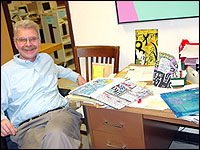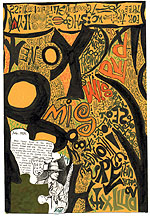Archives
Color, images and "words that aren’t words"
Michael Basinski's visual poetry flourishes in and beyond the Internet world of Webzines
By DONNA LONGENECKER
Reporter Assistant Editor
Michael Basinski, the poet, zips around in his office chair on wheels, punctuating his lines with each slide of the chair forward, sideways, down and back again, the way a dancer box-steps across the floor. He is raw energy, pulsating to a four/four beat.

Mike Basinski, pictured with some of his poems in his office in the Poetry/Rare Books Collection, describes his work as poetry—"I don't consider it visual art in any way. It is first and primarily poetry."
PHOTO: DONNA LONGENECKER
Associate curator of UB's Poetry/Rare Books Collection and a graduate of the Department of English, Basinski has been an active and visible participant in Buffalo's literary community for more than 20 years. His own work, as well as the work he archives and promotes, is more radical in form, content and expression than what is familiar and comfortable to most audiences.
Basinski's poetry is visual in form—text merging with color, images and symbols—collages that convert metaphor and myth into a landscape that begs to be touched as much as it is read. It also incorporates sound—from the familiar sound of a squeaky sneaker to glossolalia. His work is meant to be explored the way one reads maps, at times relying on a key to plot and decipher the journey.
Poets like Basinski who work in the visual poetics field submit their work to Webzines—online collections and collaborations of visual poetry. "Technology and the Internet have allowed visual poets to share their work with audiences who couldn't see the original process. Visual poets have benefited greatly from the Internet," says Basinski.

He also is a collaborative artist, having performed his work with musician Don Metz and visual artist John Toth in the East Side Media Group and later, with his ensemble, The BuFF/Fluxus Project (performance art in the tradition of Dada).
His tools are simple—magic markers, highlighters, colored pens and copy machines. The work brims with color, with clippings of medical textbook drawings, newspaper ads or botanical drawings, typographical symbols and his own renderings inserted into and around the text much like breadcrumbs left for a traveler tramping his/her way through a mythological—or real—forest. In lieu of traditional forms of submitting work, transmitting his work via the Internet has allowed him and other poets who work in visual forms to reach potentially larger audiences and, some might argue, their only appreciative audience.
"It's not art—I don't consider it art in any way, shape or form. I purposely go out of my way to say all of this is done with utensils—I don't want to infringe on the art world in any fashion," says Basinski of the visual aspect of his work. It is, essentially, a poem first, he says, and remains a poem; he considers it artistic in the way a painter or plastics artist creates artwork. When one uses language in an artistic way, he continues, then the language, the poem, becomes art.
He described how the experience of looking at ancient stone artifacts, which often are broken or shattered and have a hieroglyphic feel to them, has shaped his own work.
"You can't read it; you don't know what it means," says Basinski, who is delighted by the unknown meaning hidden in the artifact.
"I don't find it a problem that there may not necessarily be a whole fact there in order to interpret the work," he adds.
And he sees traditional expressions and forms of poetry—the "book of poetry," the poem expressed linearly in a recognizable form—as just one way of working, one way of seeing and creating poetry, although his work challenges most of what is viewed as traditional.
"I've been to a thousand poetry readings and sometimes wonder what it is people remember—if they remember anything at all when they leave," Basinski says about the more traditional experiences one might encounter at a poetry reading.
About writing and performing, he says he's very aware of his own limits and aware of the "rules" that govern traditional poetry. "Whenever I find them, I like to play with them, break them and go in the opposite direction," he says.
While he is not at all derisive of traditional, lyrical or narrative poetry, after listening to Basinski, one gets the feeling that he intends to bend, shape and shout anything he can get his hands on into "the poem."
Moreover, the constant pushing at boundaries, the movement between metaphor and myth, between symbol and the simple act of breathing—which is not taken for granted—is life for Basinski and his poems, indeed, have a pulse.
He makes few distinctions, if any, between the mundane tasks performed as part of daily life and poetry; sounds that most of us filter out or hear only as background noise become rhythmic expression—another poetic form—the spine on which the poem sings itself to life. The possibilities are endless, from the "wedding poem"—the clinking of champagne glasses to bring about the desired kiss of bride and groom at their wedding reception, to the radio broadcast beeps and hisses of Sputnik shuttling through space.
It's not that Basinski sees himself as elevating the banal to the sublime—everything is already elevated—and whether it's a shooting star or summer squash, the "subject" of a poem may have been inspired by something as routine as a trip to the supermarket or The Discovery Channel—but let him tell you about that trip to the supermarket, and you're hooked. You listen, genuinely enthralled, knowing you'll never see a watermelon in quite the same way again.
"Things began to speak to you—the Inuit belief that all things are alive, that there are creatures that inhabit inanimate objects is very much at work here—in the folk sense, since everything has life and purpose," he says.
As a poet, Basinski says he tries to find niches and spaces to work between the various schools of poetry. "I kind of like this notion of crossing camps and going from camp to camp," he explains. "It's kind of allowed me an even greater freedom because you're not under peer review and community pressure."
He is purposeful about the point of origin of his work, which is very much influenced by the seasons; he speaks of the liturgical calendar and the season of advent as thematic sources that shape his work. And, the poetry is generative, "spinning off of human relationships." He moves back and forth between a reverence for visual poetry and a humility about its origins, its tools and what he sees as his limitations in creating it—he jokes about the process.
"I found my second-grade report card in the attic the other day when I was cleaning the attic, and I found that my weakest subject at that point was spelling. I couldn't spell and I probably still can't spell, so I just made a living out of not spelling. I've made a career out of words that aren't words."
But it is much more than that. Basinski wants to crack open language the way scientists continue to crack open the mysteries of the atom—releasing its magic back into the world, freed from the fundamental strictures that a thousand years of rule-making and interpretation have wrought on the pulse of the written word.
For examples of Basinski's visual poetry see his homepage at http://wings.buffalo.edu/epc/authors/basinski/ .
